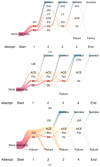Exchange of a Tracheal Tube and Supraglottic Airway Device: Evaluation of Different Techniques in Three Simulated Airway Scenarios (TUBE Study)-A Prospective, Randomised Controlled Study
- PMID: 38202022
- PMCID: PMC10779719
- DOI: 10.3390/jcm13010016
Exchange of a Tracheal Tube and Supraglottic Airway Device: Evaluation of Different Techniques in Three Simulated Airway Scenarios (TUBE Study)-A Prospective, Randomised Controlled Study
Abstract
Background: The swapping of a supraglottic airway device or a tracheal tube in anaesthetised adult patients is a challenging procedure because potential complications through hypoxemia and loss of airway may occur, with life-threatening implications. This study aims to evaluate which airway technique offers the highest success rate concerning a secure airway in established supraglottic airway and tracheal tube airway exchange scenarios.
Methods: After ethical approval, anaesthesiologists were randomised 1:1 into simulated scenarios: an LTS group (malpositioned laryngeal tube) and a Cuff group (relevant cuff leakage of a placed tracheal tube). After that, both groups completed a common scenario consisting of a partially obstructed tracheal tube lumen in a fixed prone position with a Mayfield clamp. The primary endpoint was a successful tracheal airway exchange within ten minutes after the start of the scenario and before severe hypoxemia (SpO2 < 80%) arose. Secondary endpoints were the evaluation of factors influencing success after 10 min.
Results: In total, 60 anaesthesiologists (LTS group n = 30; Cuff group n = 30) with a median experience of 7 years (IQR 4-11) were observed. Within 10 min, a malpositioned laryngeal tube was successfully exchanged by 27/30 (90%) participants, compared to the exchange of a tracheal tube with a relevant cuff leakage by 29/30 (97%; p > 0.05). An airway exchange in an obstructed tube scenario occurred in 22/59 (37%). Loss of airway maintenance showed an obvious association with failure in the common scenario (p = 0.02).
Conclusion: The results of this simulation-based study reflect that the exchange of an existing but insufficient airway device in clinical practice is a high-risk procedure. Especially in a fixed prone position, the deliberate evaluation of the existing airway patency and well-conceived airway management in the case of the accidental loss of the airway or obstructed airway access are crucial.
Keywords: airway management; anaesthesiology; existing airway device; laryngeal masks; laryngoscopy; scenario training; simulation; tracheal intubation.
Conflict of interest statement
The authors declare no conflict of interest.
Figures


Similar articles
-
Airway management in simulated restricted access to a patient--can manikin-based studies provide relevant data?Scand J Trauma Resusc Emerg Med. 2011 Jun 13;19:36. doi: 10.1186/1757-7241-19-36. Scand J Trauma Resusc Emerg Med. 2011. PMID: 21668944 Free PMC article.
-
Supraglottic airway device versus tracheal intubation in the initial airway management of out-of-hospital cardiac arrest: the AIRWAYS-2 cluster RCT.Health Technol Assess. 2022 Apr;26(21):1-158. doi: 10.3310/VHOH9034. Health Technol Assess. 2022. PMID: 35426781 Free PMC article. Clinical Trial.
-
[Intubation with a tube exchanger on an intubation trainer. Influence of tube tip position on successful intubation].Anaesthesist. 2014 Jul;63(7):563-7. doi: 10.1007/s00101-014-2342-7. Epub 2014 Jul 2. Anaesthesist. 2014. PMID: 24981151 German.
-
Awake supraglottic airway guided flexible bronchoscopic intubation in patients with anticipated difficult airways: a case series and narrative review.Korean J Anesthesiol. 2019 Dec;72(6):548-557. doi: 10.4097/kja.19318. Epub 2019 Sep 2. Korean J Anesthesiol. 2019. PMID: 31475506 Free PMC article. Review.
-
Use of intubation introducers through a supraglottic airway to facilitate tracheal intubation: a brief review.Can J Anaesth. 2012 Jul;59(7):704-15. doi: 10.1007/s12630-012-9714-8. Epub 2012 Jun 1. Can J Anaesth. 2012. PMID: 22653838 Review.
References
-
- Bernhard M., Bax S.N., Hartwig T., Yahiaoui-Doktor M., Petros S., Bercker S., Ramshorn-Zimmer A., Gries A. Airway Management in the Emergency Department (The OcEAN-Study)—A prospective single centre observational cohort study. Scand. J. Trauma. Resusc. Emerg. Med. 2019;27:20. doi: 10.1186/s13049-019-0599-1. - DOI - PMC - PubMed
LinkOut - more resources
Full Text Sources

